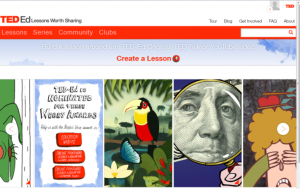An absolutely invaluable piece of software that I have been using in the classroom is the TedEd website. TED (https://www.ted.com/talks) is a great resource for video content. I will let TED describe what it is and what is does so I can do it justice:
“TED is a non-profit organisation devoted to spreading ideas, usually in the form of short, powerful talks (18 minutes or less). TED began in 1984 as a conference where Technology, Entertainment and Design converged, and today covers almost all topics — from science to business to global issues — in more than 100 languages.”
Our Mission: Spread ideas
“TED is a global community, welcoming people from every discipline and culture who seek a deeper understanding of the world. We believe passionately in the power of ideas to change attitudes, lives and, ultimately, the world. On TED.com, we’re building a clearinghouse of free knowledge from the world’s most inspired thinkers — and a community of curious souls to engage with ideas and each other, both online and at TED and TEDx events around the world, all year long.”
Ted have gone one step further and have developed their own education based website (TedEd) that can stream any of the Ted talks available online and any video from one of the partner companies YouTube. As YouTube is third most popular websites on the internet, this adds a wealth of video that can be used in an interactive blended or flipped learning experience.
Flipped Learning is explained in the infographic below. Essentially, it is about flipping the classroom. The students will be asked to watch a video as a means of input prior to a class. This input will mean they are prepared and ready for in-class activities, where the teacher can spend more time and focus on what is being produced and for any gaps in knowledge. This is something that I have been keen to explore and have used over the past year or so with my classes.
TedEd allows its users to create engaging lessons based around a video from the mentioned sources. It is simple and free to use and has a catalogue of lesson available to used directly or adapted accordingly.
The format is fairly simple to follow. You find a video that you feel is relevant to your topic. The video is embedded into the ‘Watch’ section of the page. This is the immediate input at the start of the page/lesson and is in essence the primary input for what follows. The next section (if you want it to be) is the ‘Think’ section. This is where questions related to the video can be prepared. These can be open or closed, and offer immediate feedback for any misunderstanding. The input is always available and ready to be watched again if the students need to review and consolidate. The third section of a TedEd lesson is called ‘Dig Deeper’. Here is the part of the lesson aimed at giving extra input and in any form of media deemed relevant; this adds a very connective and multimodal element to the lesson. It affords the students an opportunity to discover and explore the themes and topics at a ‘deeper’ level. The final section is aimed at preparing and performing a form of discussion. The ‘Discuss’ section can be used to set up pre-class tasks, to bring thoughts together, or give more activities that will aid the work to be done in the lesson.
Here is a lesson that I have created for my class. http://ed.ted.com/on/rdfdFEUG#watch
Normally, in a class I would ask the students to watch the video and make notes as the first half hour of the lesson. The second half would be spent using notes to support a discussion/debate about the topic. By flipping this model and asking the students to complete the TedEd lesson, it meant that the entire lesson was dedicated to the discussion, which is what they were being assessed and graded on. This led to far more informed and meaningful discussions, the register and level of discourse was improved greatly. This may, in part, be due to the topic being engaging. However, it is my belief that the input being presented at the students own pace, and the ability to have feedback on understanding, to research and discuss the themes being discussed ahead of the lesson has had a very positive impact.



Hi Mark, TedEd is such an excellent tool with so much potential that I am surprised that it’s not common knowledge. I used TED talks and videos before but have never come across, let alone used TedEd. Anyway, the lesson you created around the talk looked informative, engaging, interesting and fun. Something refreshingly different, including task based learning, with the possibilities for pre-lesson preparation or follow up learning or even self-study. You certainly made me excited about it. Thanks for sharing!
Hello Mark! Thank you sharing with such an incredible tool as TedEd . It was a valuable discovery for me as currently I’m teaching by Skype and reading in the class is not what students expect from online learning. TedEd is great way out, as students feel more motivated to read from the specially designed for them task and it not on paper or document, it’s online. The students feel very exited , and read the text or watched the video prior the class, so we have focus on more important aspect of language in the class.